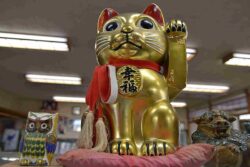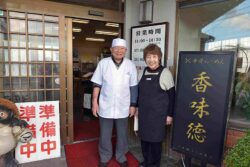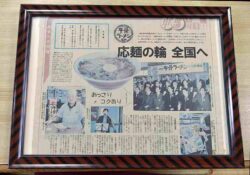
The signature dish at Kamitoku, gyukotsu ramen (600 yen)
16:31 JST, December 28, 2021
About 10 years ago, the Tottori Prefecture governor himself participated in the formation of the “O-men-dan,” a group to promote “gyukotsu ramen,” which is the signature ramen of the prefecture and, as the name implies, features a soup made from beef bones. That made the dish a hot topic in the media and sparked a sudden boom. I visited long-established Kamitoku Tottori Honten for a taste of the real thing.
White waves lapped at the shore under thick winter clouds as I drove into Kotoura, a town in central Tottori Prefecture facing the Sea of Japan. Kamitoku is located along a national road near the beach. Pulling into the spacious parking lot, the building gives off the homey atmosphere of a drive-in of the Showa period (1926-1989). Heading inside, I was met with a nostalgic showcase of food samples and a large golden maneki-neko, the lucky cat statue beckoning visitors. “Wow!” I said under my breath. The ambiance alone made me want to say, “Gochisosama.”

An exterior view of Kamitoku. It has the atmosphere of a Showa period drive-in.

An exterior view of Kamitoku. It has the atmosphere of a Showa period drive-in.

The nostalgic food sample showcase is still in use.

A golden manekineko sits in the entrance of Kamitoku.
“I heard you were coming,” said a man’s voice from the kitchen in the back. He is Takashi Kamitoku, the eldest son of the second-generation owner, Takeo. I took no time going right for the shop’s signature dishes, ordering regular-sized bowls of gyukotsu ramen (¥600) and miso ramen (¥650). “These are the beef bones,” Takashi said as he scooped thick bones with slivers of meat and fat hanging off them out of a large pot of soup on the stove. The soup is made by slowly simmering the bones with a light soy sauce. Just looking at that, I knew I was in for a treat.

The gyukotsu ramen placed in front of me consisted of a clear broth, medium-thick noodles, a slice of chashu pork, spring onions, bean sprouts, menma, and half a hard-boiled egg. Like the restaurant itself, the ramen brought me back to the Showa period. The appearance was very simple, and, while I couldn’t sense the main role played by the beef bones, their umami amid the light flavor came out with the first sip of the soup. The soup was so delicious. I could even taste sweetness in it and couldn’t stop gulping it down.

A big pot of large beef bones simmers on the stove.

Takashi deftly prepares the noodles skillfully.

Takeo’s eldest son, Takashi, prepares ramen.

The bowl on the left is for gyukotsu ramen, and slightly larger one on the right for miso ramen.

Gyukotsu soup is poured into a bowl.

The gyukotsu ramen was ready in no time.
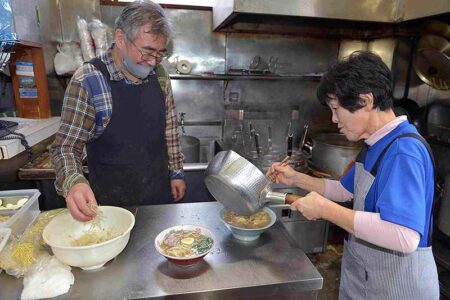
Takashi and a staff member prepare the miso ramen.
For the miso ramen, stir-fried vegetables and pork with miso paste is added to the basic gyukotsu ramen. While the color of the soup is thicker due to miso, the taste is not too strong. The aroma of the miso rises moderately, and in the end, it is easy to eat.

The noodles are medium-thick and curly.

The miso ramen is larger because it comes with stir-fried vegetables and pork.
Just as I finished my meal, 82-year-old owner Takeo, dressed in a cook’s uniform, slowly ambled over. He sat down across from me and said with a smile, “It was on the second floor here that the prefectural governor, the mayor of the town and others met together to start the O-men-dan group.”
“After the gathering, they all came down to eat ramen,” he continued. “That’s how it became famous. Many new ramen shops opened after that.” Looking closely, I could see framed newspaper articles from that time hanging here and there. They had even created a fight song.
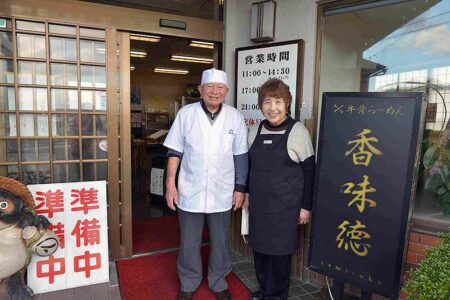
Takeo Kamitoku, owner of the restaurant, and his wife, Harue.

An article from a local newspaper hanging in the restaurant reports on the forming of the O-men-dan group for promoting gyukotsu ramen.
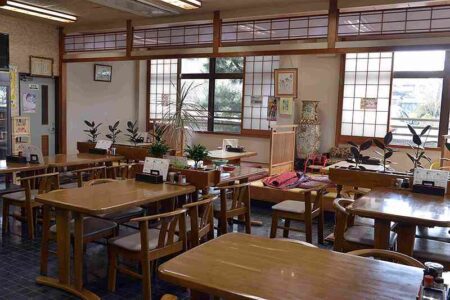
A view of the spacious interior

There are also counter seats.
In central and western Tottori Prefecture, the word “ramen” has long meant “gyukotsu ramen.” Dating back to the Edo period (1603-1867), cattle and horse markets have been set up at the foot of Mt. Daisen, making beef bones readily available. Tottori is still the home of Tottori Wagyu brand beef. The name “gyukotsu ramen” came into use around the time that the O-men-dan (a play on words from the term “oendan,” meaning supporters) was formed to market the dish as part of a prefecture-wide movement riding a national boom in local specialties.
Although the gyukotsu boom has passed, it is said that there are still about 100 restaurants in Tottori Prefecture that serve gyukotsu ramen, mainly in Kurayoshi, a city next to Kotoura, and it has spread to other parts of Japan. Among them, the long-established Kamitoku is actually not a ramen specialty shop. It offers a varied menu including tonkatsu (pork cutlet), oyakodon (rice bowl of chicken and egg), and curry and rice. After all, it is a diner for everybody. Nevertheless, since the advent of the ramen boom, gyukotsu ramen has become its signature dish.
The restaurant was established by Takeo’s father in 1949 near the current location. However, his father passed away at the age of 42, and Takeo took over the restaurant when he was 20. He has been running it for over 60 years since.
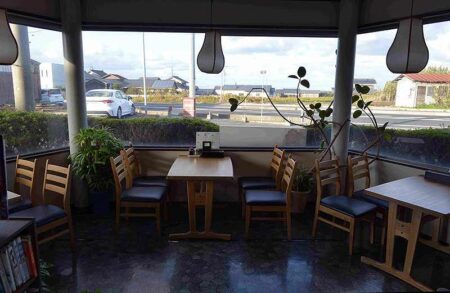
A special booth in the restaurant. Beyond the houses is the ocean.

Kamitoku’s ramen menu

In addition to ramen, there is a variety of other menu items.
The main feature of Kamitoku’s soup is that it is made daily from fresh beef thigh and rib bones. The fire on the stove is kept burning from morning to closing time, simply only simmering beef bones. The next day, the old bones are discarded and new ones are added. The taste may vary from day to day, but the light yet rich flavor remains the same.
“Cracking the big bones is hard work,” Takeo said. “I did it for decades, but now my legs are weak, so my son does it for me.”
All three of his sons are involved in keeping the Kamitoku tradition alive. While eldest son Takashi operates the main restaurant, second son Shinichi runs a branch in Ginza and third son Junichi runs one in Hawaii. There are two other shops run by Takeo’s brothers, in Kurayoshi and Hokuei Town in Tottori Prefecture.

The Japan Sea in winter gives a sense of solitude.

A small fishing village near the restaurant.
On top of that, Takashi’s son has expressed interest in eventually taking over the business. When that comes up in conversation, a charming smile comes across the face of an obviously delighted Takeo.
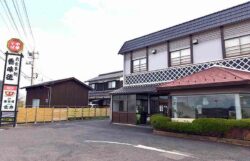
Kamitoku Tottori Honten (https://kamitokuramen.com/)
1979 Akasaki, Kotoura, Tottori Prefecture.
Lunch: 11 a.m. to 2:30 p.m. Dinner: 5 p.m. to 9 p.m. Closed on Mondays.
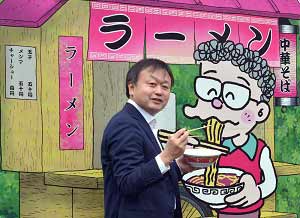
Futoshi Mori, Japan News Senior Writer
Food is a passion. It’s a serious battle for both the cook and the diner. There are many ramen restaurants in Japan that have a tremendous passion for ramen and I’d like to introduce to you some of these passionate establishments, making the best of my experience of enjoying cuisine from both Japan and around the world.
Japanese version
【ラーメンは芸術だ!】「牛骨ラーメン」の本場・鳥取の香味徳、家族で守るシンプルで懐かしい味に浸る

"JN Specialities" POPULAR ARTICLE
-

English-language Kabuki, Kyogen Entertain Audiences in Tokyo; Portland State University Professor Emeritus, Graduates Perform
-

The Japan News / Weekly Edition (11/14-11/20)
-

Yomiuri International Cooperation Prize: Prize fosters future generations of professionals
-

Tokyo’s Biggest Exhibit on Donald Keene Set to Open Saturday at Setagaya Literary Museum; Many Pieces to Be Displayed for 1st Time
-

Noodle Dining Shunsai / Rich Oyster Ramen to Savor at Odasaga; Experienced 68-year-old Owner Creates Numerous Ramen Varieties
JN ACCESS RANKING
-

Govt Plans to Urge Municipalities to Help Residents Cope with Rising Prices
-

Japan Resumes Scallop Exports to China
-

Japan Prime Minister Takaichi Vows to Have Country Exit Deflation, Closely Monitor Economic Indicators
-

Japan to Charge Foreigners More for Residence Permits, Looking to Align with Western Countries
-

JR East Suica’s Penguin to Retire at End of FY2026; Baton to be Passed to New Character


